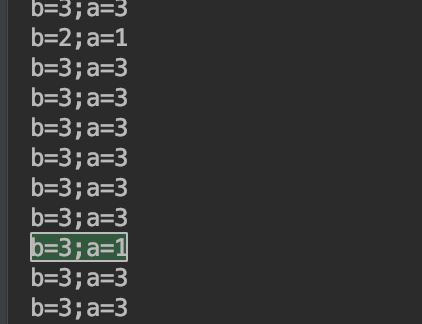本文最初来源,在此基础上做了部分修改、调整。
volatile作用
在《Java并发编程:核心理论》一文中,我们已经提到过可见性、有序性及原子性问题,通常情况下我们可以通过Synchronized关键字来解决这些个问题,不过如果对Synchronized原理有了解的话,应该知道Synchronized是一个比较重量级的操作,对系统的性能有比较大的影响,所以,如果有其他解决方案,我们通常都避免使用Synchronized来解决问题。而volatile关键字就是Java中提供的另一种解决可见性和有序性问题的方案。对于原子性,需要强调一点,也是大家容易误解的一点:对volatile变量的单次读/写操作可以保证原子性的,如long和double类型变量,但是并不能保证i++这种操作的原子性,因为本质上i++是读、写两次操作。
volatile使用场景
防止重排序
我们从一个最经典的例子来分析重排序问题。大家应该都很熟悉单例模式的实现,而在并发环境下的单例实现方式,我们通常可以采用双重检查加锁(DCL)的方式来实现。其源码如下:
1 | public class Singleton { |
现在我们分析一下为什么要在变量singleton之前加上volatile关键字。要理解这个问题,先要了解对象的构造过程,实例化一个对象其实可以分为三个步骤:
1. 分配内存空间。
2. 初始化对象。
3. 将内存空间的地址赋值给对应的引用。
但是由于操作系统可以对指令进行重排序,所以上面的过程也可能会变成如下过程:
1. 分配内存空间。
2. 将内存空间的地址赋值给对应的引用。
3. 初始化对象
如果是这个流程,多线程环境下就可能将一个未初始化的对象引用暴露出来,从而导致不可预料的结果。因此,为了防止这个过程的重排序,我们需要将变量设置为volatile类型的变量。
实现可见性
可见性问题主要指一个线程修改了共享变量值,而另一个线程却看不到。引起可见性问题的主要原因是每个线程拥有自己的一个高速缓存区——线程工作内存。volatile关键字能有效的解决这个问题,我们看下下面的例子,就可以知道其作用:
1 | public class VolatileTest { |
直观上说,这段代码的结果只可能有两种:b=3;a=3 或 b=2;a=1。不过运行上面的代码(可能时间上要长一点),你会发现除了上两种结果之外,还出现了第三种结果:
为什么会出现b=3;a=1这种结果呢?正常情况下,如果先执行change方法,再执行print方法,输出结果应该为b=3;a=3。相反,如果先执行的print方法,再执行change方法,结果应该是 b=2;a=1。那b=3;a=1的结果是怎么出来的?原因就是第一个线程将值a=3修改后,但是对第二个线程是不可见的,所以才出现这一结果。如果将a和b都改成volatile类型的变量再执行,则再也不会出现b=3;a=1的结果了。
保证原子性
volatile只能保证对单次读/写的原子性。这个问题可以看下JLS中的描述:
17.7 Non-Atomic Treatment of double and long
For the purposes of the Java programming language memory model, a single write to a non-volatile long or double value is treated as two separate writes: one to each 32-bit half. This can result in a situation where a thread sees the first 32 bits of a 64-bit value from one write, and the second 32 bits from another write.
Writes and reads of volatile long and double values are always atomic.
Writes to and reads of references are always atomic, regardless of whether they are implemented as 32-bit or 64-bit values.
Some implementations may find it convenient to divide a single write action on a 64-bit long or double value into two write actions on adjacent 32-bit values. For efficiency’s sake, this behavior is implementation-specific; an implementation of the Java Virtual Machine is free to perform writes to long and double values atomically or in two parts.
Implementations of the Java Virtual Machine are encouraged to avoid splitting 64-bit values where possible. Programmers are encouraged to declare shared 64-bit values as volatile or synchronize their programs correctly to avoid possible complications.
long和double两种数据类型的操作可分为高32位和低32位两部分,因此普通的long或double类型读/写可能不是原子的。因此,鼓励大家将共享的long和double变量设置为volatile类型,这样能保证任何情况下对long和double的单次读/写操作都具有原子性。
关于volatile变量对原子性保证,有一个问题容易被误解。现在我们就通过下列程序来演示一下这个问题:
1 | public class VolatileTest { |
大家可能会误认为对变量i加上关键字volatile后,这段程序就是线程安全的。大家可以尝试运行上面的程序。下面是我本地运行的结果:
1 | 993 |
可能每个人运行的结果不相同。不过应该能看出,volatile是无法保证原子性的(否则结果应该是1000)。原因也很简单,i++其实是一个复合操作,包括三步骤:
1. 读取i的值。
2. 对i加1。
3. 将i的值写回内存。
volatile是无法保证这三个操作是具有原子性的,我们可以通过AtomicInteger或者synchronized来保证+1操作的原子性,以下代码为使用AtomicInteger对应的实现。
1 | public class VolatileTest { |
注:上面几段代码中多处执行了Thread.sleep()方法,目的是为了增加并发问题的产生几率,无其他作用。
volatile原理
通过上面的例子,我们基本应该知道了volatile是什么以及怎么使用。现在我们再来看看volatile的底层是怎么实现的。
可见性实现
在前文中已经提及过,线程本身并不直接与主内存进行数据的交互,而是通过线程的工作内存来完成相应的操作。这也是导致线程间数据不可见的本质原因。因此要实现volatile变量的可见性,直接从这方面入手即可。对volatile变量的写操作与普通变量的主要区别有两点:
(1)修改volatile变量时会强制将修改后的值刷新的主内存中。
(2)修改volatile变量后会导致其他线程工作内存中对应的变量值失效。因此,再读取该变量值的时候就需要重新从读取主内存中的值。
通过这两个操作,就可以解决volatile变量的可见性问题。
有序性实现
在解释这个问题前,我们先来了解一下Java中的happen-before规则,JSR 133中对Happen-before的定义如下:
Two actions can be ordered by a happens-before relationship.If one action happens before another, then the first is visible to and ordered before the second.
通俗一点说就是如果a happen-before b,则a所做的任何操作对b是可见的。(这一点大家务必记住,因为happen-before这个词容易被误解为是时间的前后)。我们再来看看JSR 133中定义了哪些happen-before规则:
• Each action in a thread happens before every subsequent action in that thread.
• An unlock on a monitor happens before every subsequent lock on that monitor.
• A write to a volatile field happens before every subsequent read of that volatile.
• A call to start() on a thread happens before any actions in the started thread.
• All actions in a thread happen before any other thread successfully returns from a join() on that thread.
• If an action a happens before an action b, and b happens before an action c, then a happens before c.
翻译过来为:
- 同一个线程中的,前面的操作 happen-before 后续的操作。(即单线程内按代码顺序执行。但是,在不影响在单线程环境执行结果的前提下,编译器和处理器可以进行重排序,这是合法的。换句话说,这一是规则无法保证编译重排和指令重排)。
- 监视器上的解锁操作 happen-before 其后续的加锁操作。(Synchronized 规则)
- 对volatile变量的写操作 happen-before 后续的读操作。(volatile 规则)
- 线程的start() 方法 happen-before 该线程所有的后续操作。(线程启动规则)
- 线程所有的操作 happen-before 其他线程在该线程上调用 join 返回成功后的操作。
- 如果 a happen-before b,b happen-before c,则a happen-before c(传递性)。
这里我们主要看下第三条:volatile变量的保证有序性的规则。《Java并发编程:核心理论》一文中提到过重排序分为编译器重排序和处理器重排序。为了实现volatile内存语义,JMM会对volatile变量限制这两种类型的重排序。下面是JMM针对volatile变量所规定的重排序规则表:
| Can Reorder | 2nd operation | ||
|---|---|---|---|
| 1st operation | Normal Load Normal Store | Volatile Load | Volatile Store |
| Normal Load Normal Store | No | ||
| Volatile Load | No | No | No |
| Volatile store | No | No |
内存屏障
为了实现volatile可见性和happen-befor的语义。JVM底层是通过一个叫做“内存屏障”的东西来完成。内存屏障,也叫做内存栅栏,是一组处理器指令,用于实现对内存操作的顺序限制。下面是完成上述规则所要求的内存屏障:
| Required barriers | 2nd operation | |||
|---|---|---|---|---|
| 1st operation | Normal Load | Normal Store | Volatile Load | Volatile Store |
| Normal Load | LoadStore | |||
| Normal Store | StoreStore | |||
| Volatile Load | LoadLoad | LoadStore | LoadLoad | LoadStore |
| Volatile Store | StoreLoad | StoreStore |
(1)LoadLoad 屏障
执行顺序:Load1—>Loadload—>Load2
确保Load2及后续Load指令加载数据之前能访问到Load1加载的数据。
(2)StoreStore 屏障
执行顺序:Store1—>StoreStore—>Store2
确保Store2以及后续Store指令执行前,Store1操作的数据对其它处理器可见。
(3)LoadStore 屏障
执行顺序: Load1—>LoadStore—>Store2
确保Store2和后续Store指令执行前,可以访问到Load1加载的数据。
(4)StoreLoad 屏障
执行顺序: Store1—> StoreLoad—>Load2
确保Load2和后续的Load指令读取之前,Store1的数据对其他处理器是可见的。
最后我可以通过一个实例来说明一下JVM中是如何插入内存屏障的:
1 | public class MemoryBarrier { |
总结
总体上来说volatile的理解还是比较困难的,如果不是特别理解,也不用急,完全理解需要一个过程,在后续的文章中也还会多次看到volatile的使用场景。这里暂且对volatile的基础知识和原来有一个基本的了解。总体来说,volatile是并发编程中的一种优化,在某些场景下可以代替Synchronized。但是,volatile的不能完全取代Synchronized的位置,只有在一些特殊的场景下,才能适用volatile。总的来说,必须同时满足下面两个条件才能保证在并发环境的线程安全:
1. 对变量的写操作不依赖于当前值。
2. 该变量没有包含在具有其他变量的不变式中。